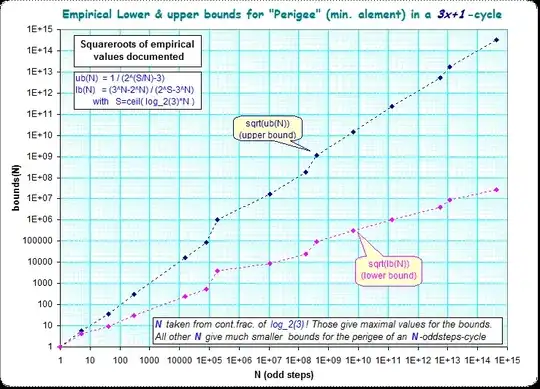Here is a table, based on computation of my earlier answer (see there). I got the N for which the lower bounds $a_\text{min_1cyc}$ are relatively highest by the continued fractions of $\lambda=\log(3)/\log(2)$.
$a_m$ is the very rough "mean" value of all $a_k$ by ${1\over 2^{S/N}-3}$, such that it is a good upper bound for $a_\min$.
A slightly better (=smaller) upper bound occurs, when the $a_1 \cdots a_N$ are assumed to be packed as tight as possible (though all different), so roughly in steps of $3$, and still solving rhs = lhs. I called it $a_\text{min_compact}$. Because the exact computation is time (or memory)-consumptive I've shown this only for $N \le 10000$
The improvement over $a_m$ however is only marginal, so this reduced display may not be critical.
A lower bound, as you have asked, occurs if we assume the $a_k$ being in a so-called "1-cycle" which means also that they have the widest distance of each other and are consecutive iterates $a_{k+1}=(3a_k+1)/2$.
The minimal $a_k$ of any type of cycle cannot be smaller than $a_\text{min_1cyc}$.
I was surprised myself when I saw such large values for the large N ,btw.
N lhs=2^S/3^N amin_1cyc amin_compact am
----------------------------------------------------------------------------------
1 (1+0.333333333333): 1.00000000000 <= a_1 <= 0 < 1
5 (1+0.0534979423868): 16.2307692308 <= a_1 <= 25 < 31.8135643475
41 (1+0.0115288518086): 86.7389013502 <= a_1 <= 1133 < 1192.08534275
306 (1+0.0010227617964): 977.744772545 <= a_1 <= 99323 < 99780.7914439
15601 (1+0.0000181947538): 54960.8972938 <= a_1 <= undef < 285817586.219
79335 (1+0.0000036647273): 272871.592753 <= a_1 <= undef < 7216102492.69
190537 (1+0.0000000645075): 15502072.2362 <= a_1 <= undef < 984572810981.
10781274 (1+0.0000000122069): 81920324.7724 <= a_1 <= undef < 2.9440182 E14
171928773 (1+0.0000000017892): 558903955.481 <= a_1 <= undef < 3.2030557 E16
397573379 (1+1.05843488 E-10): 9447912335.13 <= a_1 <= undef < 1.2520794 E18
6586818670 (1+1.01231253 E-11): 98783722251.5 <= a_1 <= undef < 2.1689015 E20
137528045312 (1+8.98654870 E-13): 1.1127742 E12 <= a_1 <= undef < 5.1012555 E22
5409303924479 (1+6.59287766 E-14): 1.5167883 E13 <= a_1 <= undef < 2.7349230 E25
11571718688839 (1+1.28966827 E-14): 7.7539319 E13 <= a_1 <= undef < 2.9908772 E26
431166034846567 (1+1.33377903 E-15): 7.4974937 E14 <= a_1 <= undef < 1.0775548 E29
A plot of that empirical values suggests, that the square-roots of the maximal $am$ (relevant $N$ indicated by the convergents of the continued fraction of $\log_2(3)$) are roughly equivalent to $N$ (the $a_{min:1cyc}$ even to seem to be equivalent to $N$). (The term "Perigee" comes from Belaga's work which has kindly been linked to by @rukhin)

